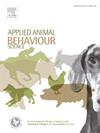The duration of urbanization influences avian escape behaviour
IF 2
2区 农林科学
Q1 AGRICULTURE, DAIRY & ANIMAL SCIENCE
引用次数: 0
Abstract
The increasing pace and scale of urbanization may have a significant impact on the birds that live within it, forcing them to adapt their behaviour to cope with the opportunities and challenges of urbanization. Understanding the impact of urbanization on bird behaviour and the process of behaviour adaptation to human disturbance is crucial for conservation and management of urban-dwelling birds. It also helps to further understand how wildlife responds to human-induced environmental changes and promotes the coexistence of wildlife and human beings. In this study, we selected urban areas with significant different initiation times of urbanization as research sites, and flight initiation distance (FID) was observed for common ground-foraging birds in these cities. The results showed that the duration of urbanization significantly affected the FIDs of birds to human in cities. Birds living in areas with longer periods of urbanization were more tolerant to human disturbance. Our study suggests that the duration of urbanization has an important influence on the escape behavior of birds to human disturbance.
城市化的持续时间影响鸟类的逃跑行为
日益加快的城市化速度和规模可能对生活在其中的鸟类产生重大影响,迫使它们调整自己的行为,以应对城市化带来的机遇和挑战。了解城市化对鸟类行为的影响及其对人类干扰的适应过程对城市鸟类的保护和管理具有重要意义。它还有助于进一步了解野生动物如何应对人类引起的环境变化,并促进野生动物与人类的共存。本研究选择城市化启动时间差异显著的城市为研究点,对这些城市常见地面觅食鸟类的飞行启动距离(FID)进行了观测。结果表明,城市化持续时间显著影响城市鸟类对人的fid。生活在城市化时期较长的地区的鸟类对人类干扰的容忍度更高。研究表明,城市化持续时间对鸟类躲避人类干扰的行为有重要影响。
本文章由计算机程序翻译,如有差异,请以英文原文为准。
求助全文
约1分钟内获得全文
求助全文
来源期刊

Applied Animal Behaviour Science
农林科学-行为科学
CiteScore
4.40
自引率
21.70%
发文量
191
审稿时长
18.1 weeks
期刊介绍:
This journal publishes relevant information on the behaviour of domesticated and utilized animals.
Topics covered include:
-Behaviour of farm, zoo and laboratory animals in relation to animal management and welfare
-Behaviour of companion animals in relation to behavioural problems, for example, in relation to the training of dogs for different purposes, in relation to behavioural problems
-Studies of the behaviour of wild animals when these studies are relevant from an applied perspective, for example in relation to wildlife management, pest management or nature conservation
-Methodological studies within relevant fields
The principal subjects are farm, companion and laboratory animals, including, of course, poultry. The journal also deals with the following animal subjects:
-Those involved in any farming system, e.g. deer, rabbits and fur-bearing animals
-Those in ANY form of confinement, e.g. zoos, safari parks and other forms of display
-Feral animals, and any animal species which impinge on farming operations, e.g. as causes of loss or damage
-Species used for hunting, recreation etc. may also be considered as acceptable subjects in some instances
-Laboratory animals, if the material relates to their behavioural requirements
 求助内容:
求助内容: 应助结果提醒方式:
应助结果提醒方式:


